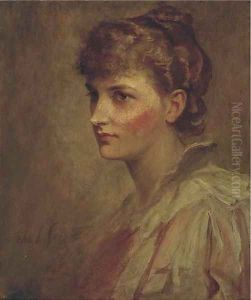John Sargeant Noble Paintings
John Sargeant Noble was a 19th-century British painter known for his depictions of animals, particularly dogs and horses, in sporting and rural scenes. He was born on January 18, 1848, in London, England. Noble developed an early interest in art, which was supported by his father, a woodcarver and artist. His talent was evident from a young age, and he was apprenticed to the famous British artist John Lucas, where he honed his skills in painting.
Noble's career as an artist flourished in the latter half of the 19th century, a time when there was a strong interest in naturalism and the accurate portrayal of animals in their environments. He exhibited at the Royal Academy from 1868, and his works were also shown at the British Institution and the Royal Society of British Artists. Noble was particularly adept at capturing the spirit and physicality of his subjects, which made his work popular with the British aristocracy and landed gentry, who were his main patrons.
Throughout his life, Noble remained dedicated to his craft. He was known to study animals intensely, often visiting the countryside to observe them in their natural habitats. This dedication to realism and detail garnered him significant recognition during his lifetime. Despite the popularity of his work, Noble was not without his critics, some of whom believed his style was too focused on sentimentality rather than artistic innovation.
John Sargeant Noble passed away on September 10, 1896, in his late forties. His legacy, though perhaps not as widely known as some of his contemporaries, endures in the collections of those who appreciate Victorian-era animal paintings and the skill required to bring such subjects to life on the canvas. Noble's work can occasionally be found on display in art galleries and at auctions, where his paintings are appreciated for their charm and technical proficiency.

